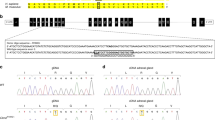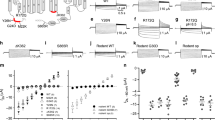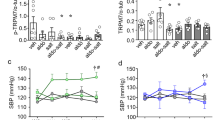Abstract
Malfunction of the circadian clock has been linked to the pathogenesis of a variety of diseases. We show that mice lacking the core clock components Cryptochrome-1 (Cry1) and Cryptochrome-2 (Cry2) (Cry-null mice) show salt-sensitive hypertension due to abnormally high synthesis of the mineralocorticoid aldosterone by the adrenal gland. An extensive search for the underlying cause led us to identify type VI 3β-hydroxyl-steroid dehydrogenase (Hsd3b6) as a new hypertension risk factor in mice. Hsd3b6 is expressed exclusively in aldosterone-producing cells and is under transcriptional control of the circadian clock. In Cry-null mice, Hsd3b6 messenger RNA and protein levels are constitutively high, leading to a marked increase in 3β-hydroxysteroid dehydrogenase-isomerase (3β-HSD) enzymatic activity and, as a consequence, enhanced aldosterone production. These data place Hsd3b6 in a pivotal position through which circadian clock malfunction is coupled to the development of hypertension. Translation of these findings to humans will require clinical examination of human HSD3B1 gene, which we found to be functionally similar to mouse Hsd3b6.
This is a preview of subscription content, access via your institution
Access options
Subscribe to this journal
Receive 12 print issues and online access
$209.00 per year
only $17.42 per issue
Buy this article
- Purchase on Springer Link
- Instant access to full article PDF
Prices may be subject to local taxes which are calculated during checkout






Similar content being viewed by others
References
Staessen, J.A., Wang, J., Bianchi, G. & Birkenhager, W.H. Essential hypertension. Lancet 361, 1629–1641 (2003).
Lifton, R.P., Gharavi, A.G. & Geller, D.S. Molecular mechanisms of human hypertension. Cell 104, 545–556 (2001).
Schibler, U. & Sassone-Corsi, P. A web of circadian pacemakers. Cell 111, 919–922 (2002).
Dunlap, J.C. Molecular bases for circadian clocks. Cell 96, 271–290 (1999).
Reppert, S.M. & Weaver, D.R. Coordination of circadian timing in mammals. Nature 418, 935–941 (2002).
Wijnen, H. & Young, M.W. Interplay of circadian clocks and metabolic rhythms. Annu. Rev. Genet. 40, 409–448 (2006).
Takahashi, J.S., Hong, H.K., Ko, C.H. & McDearmon, E.L. The genetics of mammalian circadian order and disorder: implications for physiology and disease. Nat. Rev. Genet. 9, 764–775 (2008).
Panda, S. et al. Coordinated transcription of key pathways in the mouse by the circadian clock. Cell 109, 307–320 (2002).
Green, C.B., Takahashi, J.S. & Bass, J. The meter of metabolism. Cell 134, 728–742 (2008).
Hastings, M.H., Reddy, A.B. & Maywood, E.S. A clockwork web: circadian timing in brain and periphery, in health and disease. Nat. Rev. Neurosci. 4, 649–661 (2003).
Furlan, R. et al. Modifications of cardiac autonomic profile associated with a shift schedule of work. Circulation 102, 1912–1916 (2000).
Bradley, T.D. & Floras, J.S. Sleep apnea and heart failure: Part II: central sleep apnea. Circulation 107, 1822–1826 (2003).
Scheer, F.A., Hilton, M.F., Mantzoros, C.S. & Shea, S.A. Adverse metabolic and cardiovascular consequences of circadian misalignment. Proc. Natl. Acad. Sci. USA 106, 4453–4458 (2009).
van der Horst, G.T. et al. Mammalian Cry1 and Cry2 are essential for maintenance of circadian rhythms. Nature 398, 627–630 (1999).
Vitaterna, M.H. et al. Differential regulation of mammalian period genes and circadian rhythmicity by cryptochromes 1 and 2. Proc. Natl. Acad. Sci. USA 96, 12114–12119 (1999).
Matsuo, T. et al. Control mechanism of the circadian clock for timing of cell division in vivo. Science 302, 255–259 (2003).
Yamaguchi, S. et al. Role of DBP in the circadian oscillatory mechanism. Mol. Cell. Biol. 20, 4773–4781 (2000).
Kume, K. et al. mCRY1 and mCRY2 are essential components of the negative limb of the circadian clock feedback loop. Cell 98, 193–205 (1999).
Okamura, H. et al. Photic induction of mPer1 and mPer2 in cry-deficient mice lacking a biological clock. Science 286, 2531–2534 (1999).
Mitsui, S., Yamaguchi, S., Matsuo, T., Ishida, Y. & Okamura, H. Antagonistic role of E4BP4 and PAR proteins in the circadian oscillatory mechanism. Genes Dev. 15, 995–1006 (2001).
Ishida, A. et al. Light activates the adrenal gland: timing of gene expression and glucocorticoid release. Cell Metab. 2, 297–307 (2005).
Balsalobre, A. et al. Resetting of circadian time in peripheral tissues by glucocorticoid signaling. Science 289, 2344–2347 (2000).
Young, W.F. Primary aldosteronism: renaissance of a syndrome. Clin. Endocrinol. 66, 607–618 (2007).
Kaplan, N.M. Primary aldosteronism. in Clinical Hypertension 410–433 (Lippincott Williams & Wilkins, Philadelphia, 2006).
Brown, N.J. Eplerenone: cardiovascular protection. Circulation 107, 2512–2518 (2003).
Gomez-Sanchez, C., Holland, O.B., Higgins, J.R., Kem, D.C. & Kaplan, N.M. Circadian rhythms of serum renin activity and serum corticosterone, prolactin and aldosterone concentrations in the male rat on normal and low-sodium diets. Endocrinology 99, 567–572 (1976).
Simard, J. et al. Molecular biology of the 3β-hydroxysteroid dehydrogenase/Δ5-Δ4 isomerase gene family. Endocr. Rev. 26, 525–582 (2005).
Payne, A.H. & Hales, D.B. Overview of steroidogenic enzymes in the pathway from cholesterol to active steroid hormones. Endocr. Rev. 25, 947–970 (2004).
Giroud, C.J., Stachenko, J. & Venning, E.H. Secretion of aldosterone by the zona glomerulosa of rat adrenal glands incubated in vitro. Proc. Soc. Exp. Biol. Med. 92, 154–158 (1956).
Domalik, L.J. et al. Different isozymes of mouse 11 β-hydroxylase produce mineralocorticoids and glucocorticoids. Mol. Endocrinol. 5, 1853–1861 (1991).
Ogishima, T., Suzuki, H., Hata, J., Mitani, F. & Ishimura, Y. Zone-specific expression of aldosterone synthase cytochrome P-450 and cytochrome P-45011β in rat adrenal cortex: histochemical basis for the functional zonation. Endocrinology 130, 2971–2977 (1992).
Rainey, W.E. Adrenal zonation: clues from 11β-hydroxylase and aldosterone synthase. Mol. Cell. Endocrinol. 151, 151–160 (1999).
Potts, G.O., Creange, J.E., Hardomg, H.R. & Schane, H.P. Trilostane, an orally active inhibitor of steroid biosynthesis. Steroids 32, 257–267 (1978).
Jungmann, E. et al. The inhibiting effect of trilostane on adrenal steroid synthesis: hormonal and morphological alterations induced by subchronic trilostane treatment in normal rats. Res. Exp. Med. (Berl.) 180, 193–200 (1982).
Brown, R., Quirk, J. & Kirkpatrick, P. Eplerenone. Nat. Rev. Drug Discov. 2, 177–178 (2003).
Mason, J.I. et al. The regulation of 3β-hydroxysteroid dehydrogenase expression. Steroids 62, 164–168 (1997).
Makhanova, N., Hagaman, J., Kim, H.S. & Smithies, O. Salt-sensitive blood pressure in mice with increased expression of aldosterone synthase. Hypertension 51, 134–140 (2008).
Rhéaume, E. et al. Structure and expression of a new complementary DNA encoding the almost exclusive 3β-hydroxysteroid dehydrogenase/Δ5-Δ4-isomerase in human adrenal glands and gonads. Mol. Endocrinol. 5, 1147–1157 (1991).
Abbaszade, I.G. et al. Isolation of a new mouse 3β-hydroxysteroid dehydrogenase isoform, 3β-HSD VI, expressed during early pregnancy. Endocrinology 138, 1392–1399 (1997).
Moisan, A.M. et al. New insight into the molecular basis of 3β-hydroxysteroid dehydrogenase deficiency: identification of eight mutations in the HSD3B2 gene eleven patients from seven new families and comparison of the functional properties of twenty-five mutant enzymes. J. Clin. Endocrinol. Metab. 84, 4410–4425 (1999).
Rhéaume, E. et al. Congenital adrenal hyperplasia due to point mutations in the type II 3β-hydroxysteroid dehydrogenase gene. Nat. Genet. 1, 239–245 (1992).
Peng, L., Arensburg, J., Orly, J. & Payne, A.H. The murine 3β-hydroxysteroid dehydrogenase (3β-HSD) gene family: a postulated role for 3β-HSD VI during early pregnancy. Mol. Cell. Endocrinol. 187, 213–221 (2002).
Nakada, T. et al. Primary aldosteronism treated by trilostane (3β-hydroxysteroid dehydrogenase inhibitor). Urology 25, 207–214 (1985).
Winterberg, B., Vetter, W., Groth, H., Greminger, P. & Vetter, H. Primary aldosteronism: treatment with trilostane. Cardiology 72 (Suppl 1), 117–121 (1985).
Maeda, A. et al. Circadian intraocular pressure rhythm is generated by clock genes. Invest. Ophthalmol. Vis. Sci. 47, 4050–4052 (2006).
Matsunaga, M., Ukena, K., Baulieu, E.E. & Tsutsui, K. 7α-hydroxypregnenolone acts as a neuronal activator to stimulate locomotor activity of breeding newts by means of the dopaminergic system. Proc. Natl. Acad. Sci. USA 101, 17282–17287 (2004).
Kutyavin, I.V. et al. 3′-minor groove binder-DNA probes increase sequence specificity at PCR extension temperatures. Nucleic Acids Res. 28, 655–661 (2000).
Acknowledgements
We thank T. Ono, A. Hirasawa, T. Koshimizu, K. Terasawa, H. Nishinaga, M. Sato, Y. Yamaguchi, M. Matsuo, J.M. Fustin, K. Toida, H. Sei and K. Ishimura for technical support and valuable discussion. We also thank T. Michel for critical reading of the manuscript. This work was supported in part by the Specially Promoted Research (to H.O.) and Grant-in-Aid for Young Scientists (to M.D.) from the Ministry of Education, Culture, Sports, Science and Technology of Japan and grants from Nakatomi Foundation, SRF (to H.O.), Senri Life Science Foundation, Takeda Science Foundation (to M.D.) and the Netherlands Organization of Scientific research, ZonMW Vici 918.36.619 (to G.T.J.v.d.H.). Trilostane was a generous gift from Mochida Pharmaceutical. Eplerenone was a generous gift from Pfizer.
Author information
Authors and Affiliations
Contributions
M.D. and H.O. designed the research; A.K., O.O., T.T. and G.T.J.v.d.H. supplied the experimental materials; M.D., Y.T., R.K., F.Y., H.Y., S.H., K.T. and H.O. acquired the data; M.D., N.E., Y.O., G.T., K.T. and H.O. analyzed the data; and M.D., G.T.J.v.d.H. and H.O. drafted the manuscript.
Corresponding author
Supplementary information
Supplementary Text and Figures
Supplementary Figures 1–7, Supplementary Tables 1–3 and Supplementary Methods (PDF 1570 kb)
Rights and permissions
About this article
Cite this article
Doi, M., Takahashi, Y., Komatsu, R. et al. Salt-sensitive hypertension in circadian clock–deficient Cry-null mice involves dysregulated adrenal Hsd3b6. Nat Med 16, 67–74 (2010). https://doi.org/10.1038/nm.2061
Received:
Accepted:
Published:
Issue Date:
DOI: https://doi.org/10.1038/nm.2061
This article is cited by
-
Circadian mechanism disruption is associated with dysregulation of inflammatory and immune responses: a systematic review
Beni-Suef University Journal of Basic and Applied Sciences (2022)
-
Intracrine activity involving NAD-dependent circadian steroidogenic activity governs age-associated meibomian gland dysfunction
Nature Aging (2022)
-
Time-Restricted Eating in Metabolic Syndrome–Focus on Blood Pressure Outcomes
Current Hypertension Reports (2022)
-
Management of primary aldosteronism and mineralocorticoid receptor-associated hypertension
Hypertension Research (2020)
-
The neuropeptide substance P regulates aldosterone secretion in human adrenals
Nature Communications (2020)



